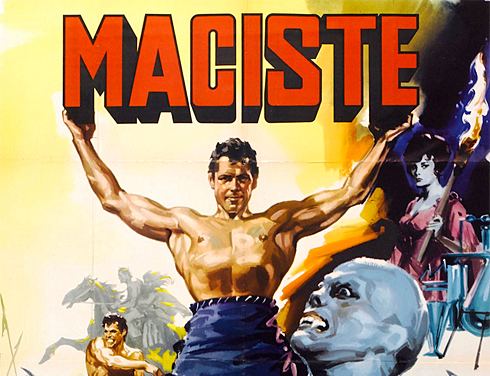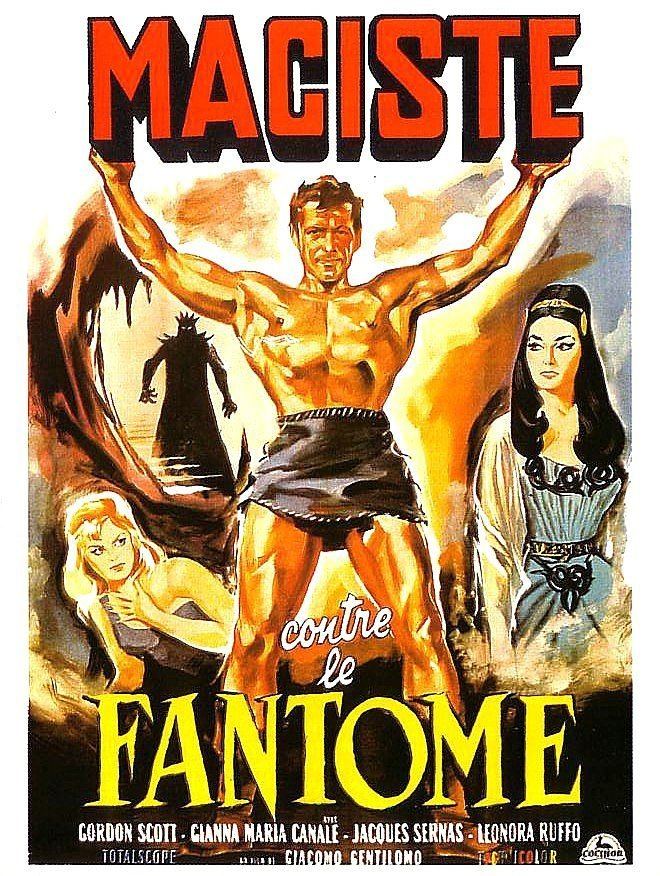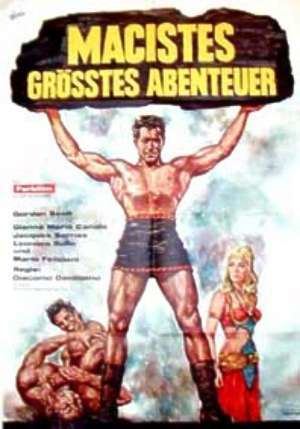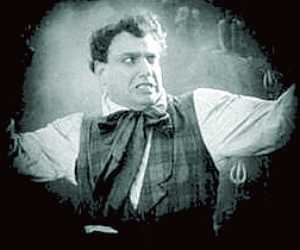 | ||
Played by Mark Forest, Kirk Morris, Gordon Scott, Bartolomeo Pagano, Alan Steel, Gordon Mitchell, Howard Ross, Reg Lewis Movies Maciste nella terra dei ciclopi, Cabiria, Samson and the Slave Qu, The Witch's Curse, Samson and His Mighty C Similar | ||
Maciste in hell 1925 movie review
Maciste ([maˈtʃiste]) is one of the oldest recurring characters in cinema, created by Gabriele d'Annunzio and Giovanni Pastrone. He cuts a heroic figure throughout the history of the cinema of Italy from the 1910s to the mid-1960s.
Contents
- Maciste in hell 1925 movie review
- Name
- Cabiria
- Bartolomeo Paganos Maciste films
- Revival of the 1960s
- Influence
- The Silent Film Series in chronological order
- The 1960s film series in chronological order
- The 1973 films of Jess Franco
- References

He is usually depicted as a Hercules-like figure, utilizing his massive strength to achieve heroic feats that ordinary men cannot. Many of the 1960s Italian films featuring Maciste were retitled in other countries, substituting more popular names in the titles (such as Hercules, Goliath or Samson).

Name

There are a number of references to the name in literarure. The name of Maciste appears in a sentence in Strabo's Geography (Book 8, Chapter 3, Section 21), in which he writes: ἐν δὲ τῷ μεταξὺ τό τε τοῦ Μακιστίου Ἡρακλέους ἱερόν ἐστι καὶ ὁ Ἀκίδων ποταμός — "And in the middle is the temple of the Macistian Heracles, and the river Acidon." The epithet Μακίστιος (Makistios, Latinized as Macistius) is generally understood to be an adjective referring to a town called Μάκιστος (Makistos) in the province of Triphylia in Elis. In the first volume of the Dizionario universale archeologico-artistico-technologico (1858) Macistius is given as one among several epithets of Hercules (Ercole). In the second volume of the same dictionary (1864) this name appears Italianized as Maciste, defined as uno dei soprannomi d'Ercole ("one of the nicknames of Hercules"). According to William Smith's A Dictionary of Greek and Roman mythology, Macistus (Μάκιστος) was "a surname of Heracles, who had a temple in the neighbourhood of the town of Macistus in Triphylia". Makistos was also the third child of Athamas and Nephele, according to the Greek mythology.

In the original draft outline of the 1914 film Cabiria by director Giovanni Pastrone, the muscular hero's name had been Ercole. In the revised script, writer Gabriele d'Annunzio gave the character the name Maciste, which he understood (based on the above or similar sources) to be an erudite synonym for Hercules.
By later writers using the character the original etymology was generally forgotten, and a folk etymology was constructed based on the name's superficial similarity to the Italian word macigno "large stone"; in the first of the 1960s films, Maciste tells another character in the film that his name means "born of the rock", and in a later film, Maciste is actually shown in one scene appearing from within a solid rock wall in a cave as if by magic.
Cabiria

Maciste made his debut in the 1914 Italian silent movie classic Cabiria. Cabiria was a story about a slave named Maciste (played by Bartolomeo Pagano) who was involved in the rescue of a Roman princess named Cabiria (played by Lidia Quaranta) from an evil Carthaginian king who plotted to sacrifice her to the cruel god Moloch. The film was based very loosely on Salammbo, a historical novel by Gustave Flaubert, and had a plot and screenplay by Gabriele D'Annunzio.

Maciste's debut set the tone for his later adventures. Including Cabiria itself, there have been at least 52 movies featuring Maciste, 27 of them being pre-1927 silent films starring Bartolomeo Pagano and the other 25 being a series of sound/color films produced in the early 1960s. Typical plots involve tyrannical rulers who practice vile magical rituals or worship evil gods. Typically, the young lady who is the love interest runs afoul of the evil ruler. Maciste, who possesses superhuman strength, must rescue her. There is often a rightful king who wants to overthrow the evil usurper, as well as a belly dance scene. There is often an evil queen who has carnal designs on the hero. These films were set in locales including Mongolia, Peru, Egypt, and the Roman Empire.
Bartolomeo Pagano's Maciste films
As a character, Maciste had two distinct moments in the spotlight. The first was in the Italian silent movie period, in which the original Maciste from Cabiria, the muscular actor Bartolomeo Pagano, starred in a series of at least 26 sequels over the period from 1915 through 1926. Then decades later, (following on the heels of the success of the two 1950s Steve Reeves "Hercules" films) Maciste was revived by Italian filmmakers for a series of 25 sound films (all made between 1960 and 1965).
The Bartolomeo Pagano silent Maciste films established the character as someone who could appear at any place and at any time. Some of the earlier ones, made during World War I, had the distinct flavour of propaganda, and cast the hero in the role of a soldier. Later films in the series return to fantasy, but the fantasy was not always mythological. Maciste appears as an Olympic athlete, in contemporary settings, or in the afterlife. His character and his plots remained consistent in whatever setting; he was always a populist Hercules, using his physical prowess to overcome the evil ruses of effete aristocrats and authority figures.
Revival of the 1960s
The character was revived in the 1960s. In 1957, Steve Reeves' Hercules, an Italian production, created a minor boom in Italian dramas featuring American bodybuilders in vaguely mythological or classical historical subjects. Maciste was the hero in 25 of these films. Other films starred such heroes as Ursus, Samson, Hercules and Goliath.
Maciste was never given an origin, and the source of his mighty powers was never revealed, nor was he confined to one specific time period/setting in his adventures. However, in the first of the 1960s Maciste films, he mentions to another character that the name "Maciste" means "born of the rock" (almost as if he was a god who would just appear out of the earth in times of need). One of the 1920s silent Maciste films was actually entitled "The Giant from the Dolomite" (another reference that he was not born as an ordinary mortal man would have been). Hence it is hinted that Maciste is more god than man, which would explain his great strength.
This sword and sandal fad continued for about six years, until the new fad for spaghetti Westerns and spy films took over the attention of the Italian cinema industry. The name Maciste was not in the title of the English versions of most of these films: when the films were imported into the USA and dubbed in English, the hero's name was often changed to Hercules, Samson, Goliath, Atlas, Ulysses or Colossus, because the name Maciste was not widely recognised in the USA. Some Italian sword and sandal films were not theatrically released in the USA; rather they premiered on American television in a syndication package called The Sons of Hercules, usually broadcast on Saturday afternoons. Best remembered for its stirring theme song, films originally featuring Maciste were dubbed into a variety of different "Sons of Hercules" pictures, with stock narration at the opening attempting to tie the film's lead character in to Hercules any way they could. A number of Italian musclemen played Maciste in the 1960s films, but Mark Forest was the actor who played Maciste the most (7 times). The other actors included Gordon Scott, Reg Park, Gordon Mitchell, Reg Lewis, Kirk Morris, Samson Burke, Alan Steel, Richard Lloyd, Renato Rossini and Frank Gordon.
Influence
The Silent Film Series (in chronological order)
The 1960s film series (in chronological order)
There were a total of 25 Maciste films from the 1960s peplum craze (not counting the two dozen silent Maciste films made in Italy pre-1930). By 1960, seeing how well the two Steve Reeves Hercules films were doing at the box office, Italian producers decided to revive the 1920s silent film character Maciste in a new series of color/sound films. Unlike the other Italian peplum protagonists, Maciste found himself in a variety of time periods ranging from the Ice Age to 16th Century Scotland. Maciste was never given an origin, and the source of his mighty powers was never revealed. However, in the first film of the 1960s series, he mentions to another character that the name "Maciste" means "born of the rock" (almost as if he was a god who would just appear out of the earth itself in times of need). One of the 1920s silent Maciste films was actually entitled "The Giant from the Dolomite", hinting that Maciste may be more god than man, which would explain his great strength.
The first title listed for each film is the film's original Italian title along with its English translation, while the U.S. release title follows in bold type in parentheses. (Note how many times Maciste's name in the Italian title is altered to an entirely different name in the American title):
The 1973 films of Jesús Franco
In 1973, the Spanish cult film director Jesús Franco directed two low-budget "Maciste films" for French producers: Maciste contre la Reine des Amazones (Maciste vs the Queen of the Amazons) and Les exploits érotiques de Maciste dans l'Atlantide (The Erotic Exploits of Maciste in Atlantis). The films had almost identical casts, both starring Wal Davis as Maciste, and appear to have been shot back-to-back. The former was distributed in Italy as a "Karzan" movie (a cheap Tarzan imitation), while the latter film was released only in France with hardcore inserts as Les Gloutonnes ("The Gobblers"). Despite their titles; these two films were totally unrelated to the 1960s Italian Maciste series; Maciste was presented as a 16th-century French adventurer who travels overseas to exotic lands.
